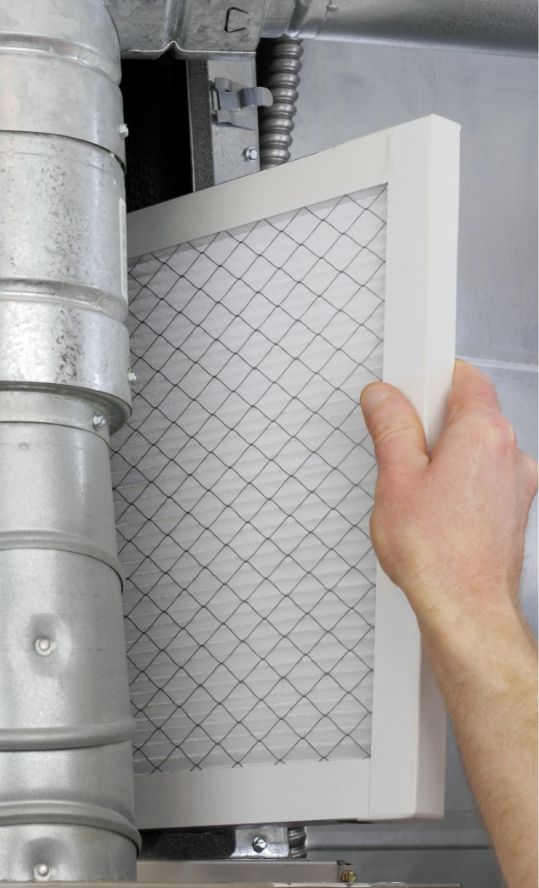
Breathing Easy
WHEN IT COMES TO INDOOR AIR QUALITY, WE’RE ALREADY OFF TO A GOOD START.
This year has been unusual and challenging, to say the least. For most of us, we’ve spent the majority of our time fearing places where we normally find connection and comfort, like restaurants, our offices, and friends’ homes. The conversation around the dinner table has been largely dominated by talk of viruses and public health. We’ve started to obsessively focus on something we can’t even see: the air that surrounds us, which we breathe, and which we share with others.
While it’s true there’s more than meets the eye when it comes to indoor air quality, it doesn’t mean we need to fear it. What we need is to understand the basics of what contributes to good indoor air quality, and to learn how we can go from good to great.
SARS-Cov-2 isn’t the only harmful substance in our air. Given that we spend about 90% of our time inside, we should be keenly aware of how to keep our indoor air quality at its best. The good news is, living in Western Canada, we’re already starting with relatively good quality outdoor air, which we draw into our buildings, condition, and filter repeatedly as the air gets recirculated over and over again. In Class A Commercial Office buildings, like the ones found in most of our urban centres, there is a team of people who actively monitor and manage ventilation and filtration systems so that they’re performing well enough to keep our buildings clean, safe, and healthy for their occupants and for the built-environment.
Contributors to indoor air.
Your indoor air contains a mix of tiny solid particles and liquid droplets found in the air, which comes from a few key sources:
- Outdoor air, which comes in through the air intake system and via doorways and the building envelope, etc. (sometimes this can also be the neighboring building)
- Elements of the building and key fixtures, like indoor plants, living walls, building material, and paint
- The building’s operations and activities such as food preparation, washroom facilities, office equipment, and
- People: often the biggest contributor of poor IAQ
These avenues of transmission all generate and compound the undesirable contaminants in the indoor air. The most common air pollutants are: bacteria and viruses; volatile organic compounds (VOCs) emitted from paint, building cleaners, photocopiers, and solvents; allergens like mold, dust, dirt, and pollen; particulate, especially those in the size range of 2.5 micrometers and smaller (PM2.5) and industrial gases such as carbon monoxide, carbon dioxide, chlorine, sulfur dioxide, nitrogen oxide and ammonia.
When this contaminated air enters the building or recirculated without being filtered and cleaned, the pollutants can get into our bodies and make us sick over time.
How to keep your indoor air clean.
There are four key elements that contribute to the quality of your building’s indoor air. The systems associated with each of these elements must be regularly maintained and tested to make sure they’re functioning properly. The systems work hand in hand, and any deficiency in one lowers the overall efficacy of your indoor air.
SOURCE CAPTURE
Source capture includes areas and activities within a building where contaminants are collected and/or directly exhausted out of the building. Common examples of source capture include bathroom fans, hood fans above cooking ranges, and activities such as a hair salon or fitness room.
FILTRATION
Filtration is the number one defense for the removal of harmful and unwanted contaminants. As important as the filter efficiency (MERV 13 or better) even more so is the filter integrity. If the filter doesn’t fit properly, is improperly sealed, or the filter bank is damaged, the overall filter efficiency decreases dramatically.
MECHANICAL VENTILATION
This is the distribution of filtered outdoor and recirculated air throughout a building or space. Filtered ventilation keeps air moving and is helpful in reducing harmful substances.
HUMIDIFICATION
Increased relative humidity (RH) reduces the viability of some viruses and bacteria. In cold, dry climates like Alberta, it is difficult to naturally maintain a healthy relative humidity. For this reason, we need to mechanical humidify in an effort to obtain a 40-60% RH. At this RH viruses like SARS-CoV-2 are not as viable.
Getting from good to great.
In Western Canada, we’re fortunate to have a solid foundation for our indoor air systems. If your company or facility is one that already has high quality indoor air, ensuring that your entire system is functioning as efficiently as possible, your next priority should be moving from a ‘prevention & maintenance’ cycle to a ‘real-time monitoring & optimizing’ cycle.
There is so much technology that is being advanced to optimize the health of indoor spaces. New ways of identifying and specifying particulate matter are emerging as more research is done. But for people who spend their time looking after typical indoor spaces, the three keys to optimization are: real-time monitoring, room air purification and education.
BUILDING PERFORMANCE MONITORING
Technology is available to monitor your indoor air quality in real time, enabling you to identify and eliminate risk before it affects occupants. Articulating results to building occupants and stakeholders will offer peace of mind as to the quality of the air they are breathing.
ROOM AIR PURIFICATION
In spaces with increased occupancy and inadequate ventilation, room air purifiers can help dilute and clean the air in a more targeted manner.
TRAINING & EDUCATION
Indoor air quality is a discipline all its own. The more you know, the more you can do to prevent harmful situations from building up. The function of filter inspection, service, replacement and disposal has evolved to an area of specialization. Those that are performing these tasks should be trained so they fully understand what they are dealing with. National Air Filtration Association (NAFA) has information on training and certification programs.
The silver lining for 2020 is that people are asking more questions, holding each other more accountable, and ultimately keeping us all safer by knowing more about indoor air quality. If you’re still uncertain about your building’s indoor air, talk to your building operations manager, or a NAFA-certified expert, like the ones at BGE Indoor Air Quality.
Together, we’ll continue to elevate the conversation of indoor air quality.

Your Partners In Clean Air
Call 780-436-6960 today to speak with a BGE Clean Air Advisor.




